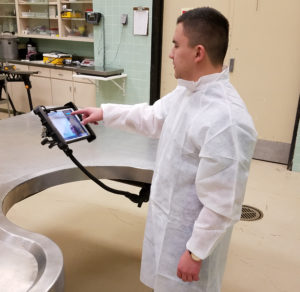Laboratory collaboration project breaks down traditional communication barriers
Earlier this month, the Institute for Infectious Animal Diseases (IIAD) in partnership with the Texas Center for Applied Technology (TCAT) hosted an exercise that demonstrated the efficacy of a digital content sharing and collaboration network that will increase communication and collaboration between both conventional and high containment animal health diagnostic and research laboratories. The exercise for the Multi-Laboratory International Collaboration Environment (MICE) project was held in US laboratories and was originally conceived from a system developed by the Commonwealth Scientific and Industrial Research Organisation (CSIRO), Australia’s federal agency for scientific research.

“This system allows for the breaking down of the traditional barriers to communication into and out of the diagnostic laboratory environment,” said Matt Cochran, DVM, MIA, IIAD program director. “It gives laboratorians a simple way to really interact with each other and each other’s work, whether across the country from one another or across the globe.”
Funded by the Department of Homeland Security Science and Technology (DHS S&T) Chemical and Biological Defense Division, the two-year project aimed to investigate, implement, pilot and evaluate a virtual collaborative environment that supports bringing together both the diagnostic subject-matter experts and the laboratorians working in veterinary diagnostic laboratories. This exercise demonstrated the utility of the concept and system in supporting research, virtual training, and communication during a simulated, potentially high consequence disease occurrence.
The exercise was structured as a multi-node, multi-laboratory simultaneous engagement using the MICE system. The five laboratories that participated in the exercise included: Texas A&M Veterinary Medical Diagnostic Laboratories in College Station and Amarillo, Kansas State Veterinary Diagnostic Laboratory, Kansas State University’s Biosecurity Research Institute and the Plum Island Animal Disease Center. In addition, participants were present from DHS S&T, Kansas Department of Agriculture, and the National Agriculture Biosecurity Center.
“The verbal and written feedback received from the pilot participants was very positive,” said Keith Biggers, Ph.D., TCAT Director of Computing and Information Technology. “There was substantial engagement and significant excitement around the demonstrated capability, allowing for laboratories to share and discuss high quality imagery directly from laboratory instruments, support future virtualized trainings, and perform collaborative research and discovery. The captured feedback, outcomes, and lessons learned will be published in a formal report which will be delivered in early June.”
Following project assessment reports, IIAD will coordinate with DHS about potential follow-on piloting expansion, as well as longer-term technology and infrastructure transition and sustainment.


